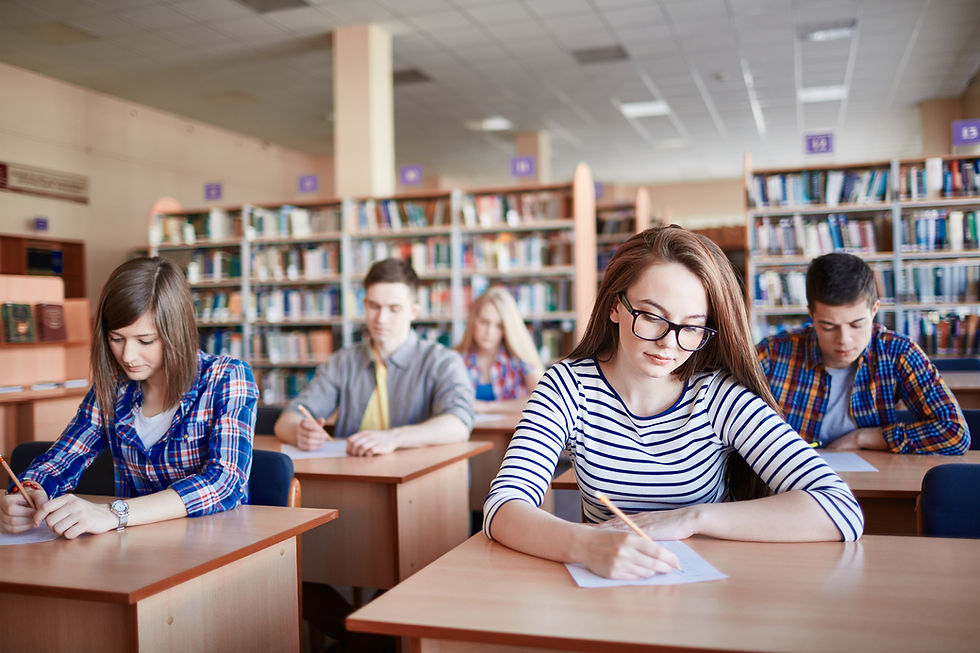The Role of Physical Activity in Developing Numeracy Skills
- Elias Mbanze

- Apr 26, 2022
- 7 min read
Updated: May 29, 2022
This blogpost argues for the necessity of physical activity in learning of numeracy skills (mathematics) from a neuroscientific perspective by providing evidence from research. Recommendations are made for mathematics teachers to include short bouts of physical activities in their lesson planning.

Introduction
Several theorists have postulated the various attributes of child development and their implications for learning, and how the potential in childhood can be honed to ensure maximum learning output (Brunner, 2004; Vygotsky, 1978 & Piaget, 1952). For this purpose, learning is encouraged especially in the early years. The first step in learning is language acquisition, which begins already when the child is still in the mother's womb (Clark and Casillas, 2017). Learning in utero has been further supported by e.g., Casper and Spence (1986) who note that new-borns can discriminate between passages read out loud by their mothers from unfamiliar ones in the last six weeks of pregnancy. As language is acquired, the child is also introduced to numeracy and number sense. From infancy, the child already possesses number sense as they can tell the differences in quantity (Dahaene, 2011). As they progress from infancy, their number sense improves significantly. They start to associate numerical figures and physical objects and begin to count. Over the course of the school years, their understanding of numbers and number relations increase to the level where they can make mathematical abstractions. Using research from the fields of neurology and psychology, we can implement methods that support optimal learning in mathematics as well as other subjects. This short blog post explores the benefits of physical activity in the development of numeracy skills by citing research from the field of neuroscience. The information provided here is aimed at mathematics teachers at all levels of mathematical learning.

Numeracy
In simple terms, numeracy is the ability to apply basic numerical reasoning in daily life. It involves recognizing and understanding the role of basic mathematical operations in dealing with daily life such as dividing things among members of the class or family, counting items, measuring distances and time, determining costs. Possessing numeracy skills is, therefore, important for daily functioning in the current world. It is for this reason that mathematics teaching in school emphasises numeracy,
especially in the early years of learning. In many education systems around the world, the aspects of numeracy that are widely taught at school-level mathematics focus on number sense, measurements, geometry, and statistics. Other important topics are algebra, functions and relations, and mathematical logic.
In their study, ‘Does Numeracy Matter?’, Bynner and Parsons (1997) showed a correlation between poor numeracy and school dropout rates. People with poor numeracy skills usually dropped out of school without attaining the intended qualifications and thus ending up in casual work and unemployment. Since the technological developments in the modern world have made low skilled and unskilled jobs obsolete (Bynner and Parsons, 2005), it is important that everyone earns the necessary skills required for skilled employment in the manufacturing and service industries that dominate modern economies. Mathematics plays a crucial role in the development of most skills that are necessary in the job market (Odumosu, 2008). Therefore, methods of improving acquisition of numeracy (mathematical) skills need to be incorporated in teaching activities to ensure that students get the necessary knowledge for their career development as well as to remedy the situation of dropouts.

Physical Activity
Physical activity may be defined as any bodily movement resulting in energy expenditure (US Department of Health and
Human Services, 2018). Based on this definition, it can involve a variety of activities including running, swimming, dancing, skipping rope, and other related activities. The health benefits of physical activities have been established by a considerable number of publications. Whether it is for improved cardiovascular health, blood circulation or for simply building muscles, the benefits of a physically active lifestyle are numerous. Research further points to benefits of physical activity to children and adolescents in the form of better health and improved cognitive function (Janssen et.al., 2010). Improved cognitive function is important in education as better cognition can be associated with improved learning outcomes. It has also been shown in literature that physical activity is better for adolescents’ improved self-image and self-esteem (Dishman et.al., 2006)

Evidence from Neuroscience
Malividii et.al. (2017) examined the effects of a 4-week programme that integrated movement into cognitive tasks related to numerical skills at preschool level, and found that, at all the three points of testing used during the study (pre-test, post-test, and delayed post-test), the children who engaged in learning tasks that integrated physical activity performed better than the other groups. These results relate to the findings from neuroscience studies that indicate that physical activity improve memory and learning in animals, and promotes the creation of new neurons (Ploughman, 2009). This indicates improved cognition as more neural links are created. By engaging in challenging tasks such as calculations or working with numbers, these newly created neural links can be consolidated. Therefore, physical activity is not only important in contributing to improved numeracy, but also good for cognitive health.
Furthermore, Hansen (2016) has reported that study participants who engaged in physical activity developed a more effective brain as the connections between the lobes of the brain strengthened. This suggests that these different areas of the brain were better integrated, thus implying that the brains of these participants functioned more efficiently. An efficient brain is necessary for performing demanding tasks such as mathematical computations. According to Hillman et.al. (2008), a positive correlation exists between fitness and mathematics scores as well as reading scores. Students with higher fitness scores performed better in mathematics and reading standardized tests than those with lower fitness scores. In most cases, the common belief is that students who are physically active at school (those who engage in sports) usually achieve poor academic results. Popular culture has cemented this belief through movies and TV shows that portray the “genius” as an indoor individual who does not do any sports and can be sometimes out of shape. The so-called “jock” is only muscle bound and physically fit but not intelligent. This is contrary to what the scientific data shows.
When considering the human brain from an evolutionary perspective, there is evidence indicating that over the history of human evolution, the brain has adapted to respond to physical exercise as humans evolved from sedentary hominids to active hunter-gatherers (Raichlen & Alexander, 2017). This suggests that humans are naturally active organisms with a need for frequent physical activity. Raichen and Alexander (2017) further claim that a less active lifestyle common in many industrialised societies lead to reduced organ capacities which predisposes the individual to chronic illnesses. Considering the school set up in most countries around the world, one can already deduce that
students do not engage in a significant amount of physical activity as most lessons take place in the classroom where the student is expected to sit and listen to the teacher for a prolonged time.

Recommendations to Educators
Based on recent research, physical activity is recommended in learning situations to ensure that the students gain the associated benefits. Vetter et.al. (2020) report improved scores in multiplication and general numeracy in pupils who learned multiplication concurrently with physical activities that included a shuttle run, a circuit, and paired relays that used game props such as dominoes, number charts and worksheets, and a wrap-up ‘recall’ ball game. Even though the idea of engaging in playful activity while learning might sound counterproductive or cumbersome to some educators, it should be noted that engaging in physical activity before commencement of a lesson also showed an improvement in mathematics and general numeracy, though slightly lower than in the playground group (Vetter et.al., 2020). I would therefore recommend that mathematics teachers take this into consideration. Plan your lesson so that you reserve at least 10 to 15 minutes of physical activity before the lesson or during the lesson, especially when teaching challenging topics.
It should, however, be noted that physical activity should be carried out in moderation as high intensity exercise has been responsible for increased corticosterone (stress hormone) levels in rats (Griesbach et.al., 2012). Furthermore, Griesbach et.al. (2012) also showed that forced exercise was more likely to lead to elevated stress as opposed to voluntary exercise. Therefore, educators should consider how physical activity is incorporated in learning. It would be prudent to use light physical activity such as body movements, short dance sessions, running over short distances, or jumping for a few minutes as opposed to rigorous physical activity. It would also be a good alternative to take students’ suggestions into account.

Elias Mbanze is a student in the Masters in Changing Education programme at the Faculty of Educational Sciences at the University of Helsinki. He originates from the small town of Rundu in the north-eastern part of Namibia. He has a Bachelor of Education from the University of Turku with a major in Educational Sciences. Elias has taught mathematics and Natural sciences at primary and middle school level in Windhoek, Namibia since graduating in 2019 until August 2021. He is passionate about the field of education, and he is especially dedicated to researching methods that can improve teaching and learning in STEM subjects.
References
Bruner, J. (2004). A short history of psychological theories of learning. Daedalus, 133(1), 13-20.
Bynner, J. and Parsons, S. (1997). Does Numeracy Matter? London: The Basic Skills Agency.
Clark, E. V., & Casillas, M. (2015). First language acquisition (pp. 327-344). Routledge.
Dehaene, S. (2011). The number sense: How the mind creates mathematics. OUP USA.
DeCasper, A.J. and Spence, M.J. (1986) Prenatal maternal speech influences newborns’ perception of speech sounds. Infant Behav. Dev. 9, 133–150.
Dishman, R. K., Hales, D. P., Pfeiffer, K. A., Felton, G. A., Saunders, R., Ward, D. S., ... & Pate, R. R. (2006). Physical self-concept and self-esteem mediate cross-sectional relations of physical activity and sport participation with depression symptoms among adolescent girls. Health psychology, 25(3), 396.
Griesbach, G. S., Tio, D. L., Vincelli, J., McArthur, D. L., & Taylor, A. N. (2012). Differential effects of voluntary and forced exercise on stress responses after traumatic brain injury. Journal of Neurotrauma, 29(7), 1426-1433.
Hansen, A. (2017). The Real Happy Pill: Power Up Your Brain by Moving Your Body. Simon and Schuster.
Hillman, C. H., Erickson, K. I., & Kramer, A. F. (2008). Be smart, exercise your heart: exercise effects on brain and cognition. Nature reviews neuroscience, 9(1), 58.
Janssen, I., & LeBlanc, A. G. (2010). Systematic review of the health benefits of physical activity and fitness in school-aged children and youth. International journal of behavioral nutrition and physical activity, 7(1), 1-16.
Mavilidi, M. F., Okely, A., Chandler, P., Domazet, S. L., & Paas, F. (2018). Immediate and delayed effects of integrating physical activity into preschool children’s learning of numeracy skills. Journal of experimental child psychology, 166, 502-519.
Olukemi, O. M., & Gbenga, O. E. (2016). Relevance of Mathematics education to entrepreneurship skills acquisition towards the realization of vision 20: 2020. International Journal for Cross-Disciplinary Subjects in Education (IJCDSE), 7(2), 2768-2773.
Parsons, S., & Bynner, J. (2005). Does numeracy matter more?.
Piaget, J., & Cook, M. T. (1952). The origins of intelligence in children.
Ploughman, M. (2008). Exercise is brain food: the effects of physical activity on cognitive function. Developmental neurorehabilitation, 11(3), 236-240.
Raichlen, D. A., & Alexander, G. E. (2017). Adaptive capacity: an evolutionary neuroscience model linking exercise, cognition, and brain health. Trends in neurosciences, 40(7), 408-421.




Comments